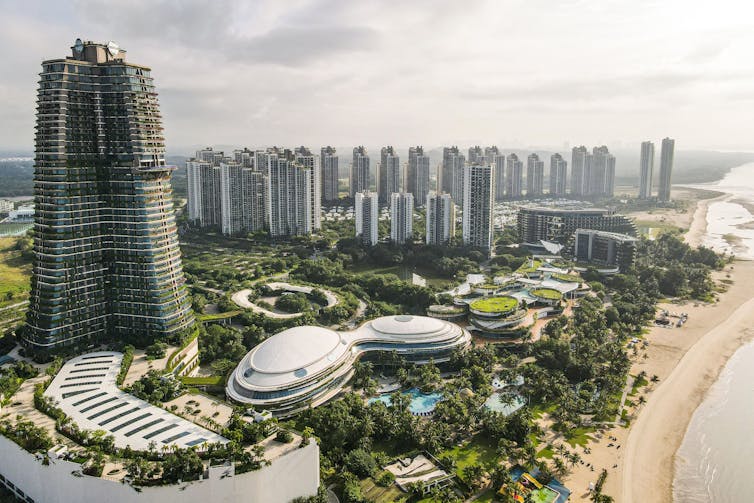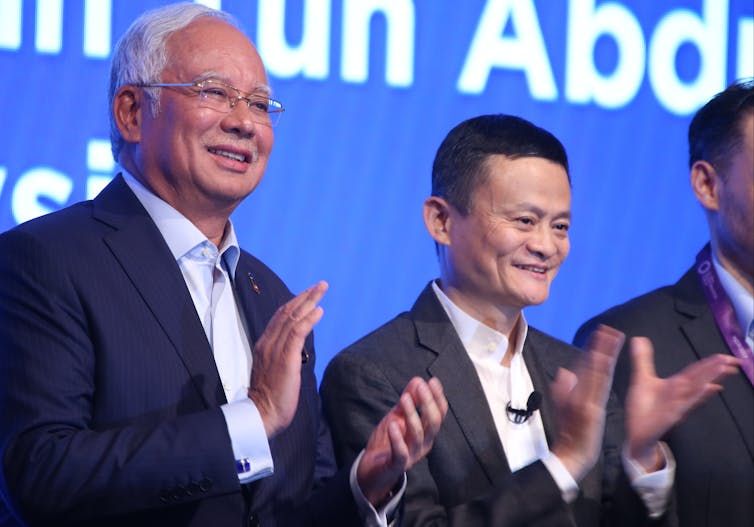By Richard Carney*
China currently faces daunting challenges in its domestic economy. But weakness in the real estate market and consumer spending at home is unlikely to stem its rising influence abroad.
In mid-October 2023, China celebrated the 10-year anniversary of its Belt and Road Initiative, or BRI. The BRI seeks to connect China with countries around the world via land and maritime networks, with the aim of improving regional integration, increasing trade and stimulating economic growth. Through the expansion of the BRI, China also sought to extend its global influence, especially in developing regions.
During its first decade, the initiative has faced a barrage of criticism from the West, mainly for saddling countries with debt, inattention to environmental impact, and corruption.
It has also encountered unexpected challenges – notably the COVID-19 pandemic, which led to massive supply chain issues and restrictions on the movement of Chinese workers overseas. Yet, as the BRI heads into its second decade, global economic trends suggest it will continue to play an important role in spreading Chinese influence.
I’m an associate professor of global studies at the Chinese University of Hong Kong, Shenzhen, where I teach about business-government relations in emerging economies. In my new book, “China’s Chance to Lead,” I discuss which countries have already and are now most likely to seek out and benefit from Chinese spending. Understanding this helps explain why China and the Belt and Road Initiative are poised to benefit greatly from the global economy over the next several decades.
Malaysia’s unlikely prominence
In October 2013, China President Xi Jinping announced the launch of the maritime portion of the BRI during a speech in Jakarta. At the time, Indonesia appeared to be an ideal candidate for Chinese infrastructure spending, yet it was Malaysia – surprisingly – that emerged as a far more avid participant.

In comparison to Malaysia, Indonesia’s economy was three times larger and its population nearly nine times bigger, yet its gross domestic product per capita only was one-third as high. Indonesia also had enormous potential to increase its already substantial natural resources exports to China. Taken together, these factors point to Indonesia’s far greater demand for infrastructure that would aid its economic development.
Furthermore, Indonesia’s democratic institutions were more conducive to attracting foreign investment. Its checks and balances enhanced policy stability and reduced political risk. By contrast, Malaysia’s government, which was dominated by a single ruling party coalition, lacked comparable checks and balances.
Despite Indonesia’s numerous advantages, Malaysia attracted a far larger volume of BRI spending during its first several years. Data provided by the China Global Investment Tracker indicates the value of newly announced infrastructure projects in Malaysia surged from US$3.5 billion in 2012 to over $8.6 billion in 2016. Spending in Indonesia, meanwhile, rose modestly from $3.75 billion to $3.77 billion over the same period.
Malaysia also enthusiastically participated in the Digital Silk Road, or DSR, launched in 2015. The DSR is the technological dimension of the BRI that aims to improve digital connectivity in Belt and Road countries. Malaysia Prime Minister Najib Razak engaged Jack Ma, the co-founder of Chinese tech giant Alibaba, as an adviser to develop e-commerce in 2016. This led to the creation in 2017 of a Digital Free Trade Zone, an international e-commerce logistics hub next to the Kuala Lumpur International Airport.
With this foundation in place, Malaysia’s capital went on to become the first city outside China to adopt Alibaba’s City Brain smart city solution in January 2018. City Brain uses the wealth of urban data to effectively allocate public resources, improve social governance and promote sustainable urban development. Dubai and other cities in the Middle East followed.
Digital Silk Road projects in Indonesia during that period were far fewer, slower and less ambitious. They primarily involved the expansion of Chinese smartphone and e-commerce firms in Indonesia.
What accounts for these contrasting responses? The short answer: their political regimes. And understanding that could be key to the global spread of Chinese influence in the coming years.
State-owned business and clientelism
In the lead-up to the May 2018 election, Malaysia’s ruling party and its allies worried they could lose power after six decades of rule. Desperate to bolster support, Najib quickly identified numerous infrastructure megaprojects in which Chinese state-owned businesses could partner with Malaysian counterparts.
Indonesia, by contrast, placed far greater emphasis on projects led by private business. For example, the Indonesia Morowali Industrial Park, “the world’s epicenter for nickel production,” is one of the largest Chinese investments in Indonesia and a joint venture between private Chinese and Indonesian companies.
As I discuss in my book, when rulers in autocracies with semi-competitive elections, like Malaysia’s, have a weak hold on power, their desire for Chinese spending is amplified. This relates to clientelism, or the delivery of goods and services in exchange for political support.
A higher level of state control in autocracies grants political leaders greater influence over the allocation of clientelist benefits, which aids leaders’ reelection efforts.

Economic trends that will benefit China
Even if China’s future growth is lower than the pre-pandemic period, these four features of the global economy are poised to benefit China and the Belt and Road Initiative over the next several decades.
1. Global rise of autocracies
Over 60% of developing countries are autocratic, according to data provided by the Varieties of Democracy Project. This represented 72% of the global population in 2022, up from 46% in 2012.
For decades, the World Bank and affiliated regional development banks were the only game in town for development financing to low- and middle-income countries. Consequently, these global lenders could demand liberalizing reforms that were sometimes contrary to the interests of incumbent rulers, especially autocrats.
China’s rise has created an attractive alternative for autocratic regimes, especially since it does not impose the same kinds of conditions that often require loosening state controls on the corporate sector and reducing clientelism. Between 2014 and 2019, I find that 77% of total BRI spending on construction projects went to autocracies, and primarily to those with semi-competitive elections.
2. Demand for Chinese infrastructure spending
The economies of developing countries have grown more than twice as quickly as advanced economies since 2000 and are projected to outpace advanced economies in the decades ahead. On the eve of the Soviet Union’s dissolution in 1991, developing economies accounted for 37% of global GDP; by 2030, the International Monetary Fund projects they will account for around 63%.
At the same time, the global infrastructure financing gap – that is, the money needed to build and upgrade existing infrastructure – is estimated to be around $15 trillion by 2040. To fill this gap, the world must spend just under $1 trillion more than the previous year up through 2040, with most of this spending directed toward low-income economies.
Because many of these fast-growing, low-income countries are predominantly semi-competitive autocracies, China is well-positioned to expand its global influence via the Belt and Road Initiative.
3. Emerging tech
The advent of what is known as Industry 4.0 technologies, such as artificial intelligence, big data analytics and blockchain, could enable developing countries to leapfrog stages of development.
By creating new technical standards to be used in these emerging digital technologies, China aims to lock in Chinese digital products and services and lock out non-Chinese competitors wherever its standards are adopted.
In Tanzania, for example, the Chinese company contracted to deploy the national ICT broadband network constructed it to be compatible only with routers made by Chinese firm Huawei.
Incorporating digital technologies into hard infrastructure projects – digital traffic sensors on roads, for example – presents more opportunities for China to use the Belt and Road Initiative to promote adoption of its technologies and standards globally.
4. Urbanization
Finally, the developing world’s urban population is expected to rise from 35% in 1990 to 65% by 2050. The biggest increases will likely occur in the semi-competitive autocracies of Africa. A desire for sustainable urbanization will increase the demand for infrastructure that incorporates digital technologies – once again amplifying the opportunity for China and the BRI.
Understanding what drives the demand for the Belt and Road Initiative, and the trends that will propel it into the future, is vital for the West to devise an effective strategy that counters China’s rising global influence.![]()
* Richard Carney, Associate professor of global studies, Chinese University of Hong Kong, Shenzhen. This article is republished from The Conversation under a Creative Commons license. Read the original article.
2 Comments
'Finally, the developing world’s urban population is expected to rise from 35% in 1990 to 65% by 2050
By who(m)?
Back-casting to project forward, blinkers firmly attached. Different politics, same siloed academia.
Hmm just make sure you check the aeration levels in their concrete!!!
We welcome your comments below. If you are not already registered, please register to comment.
Remember we welcome robust, respectful and insightful debate. We don't welcome abusive or defamatory comments and will de-register those repeatedly making such comments. Our current comment policy is here.